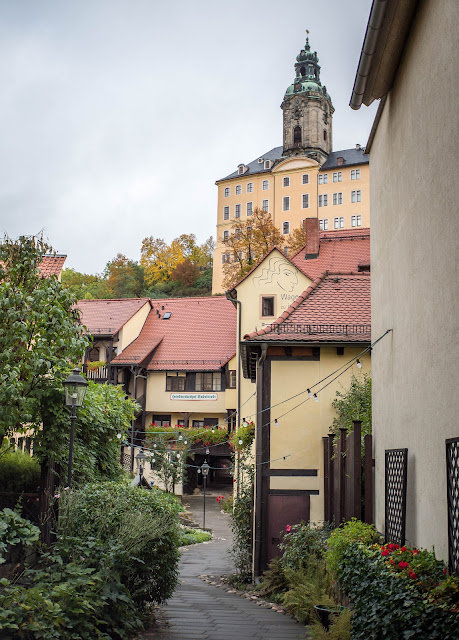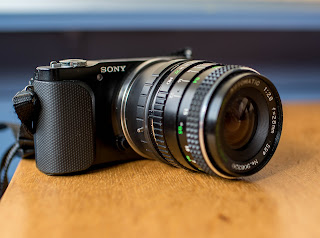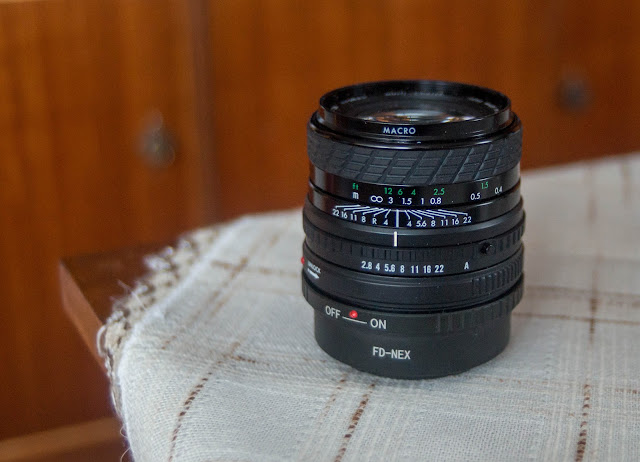 |
| Neewer 28mm/2.8 at f/2.8, 1/400s, ISO 200 |
According to the manufacturers' advertising: "Neewer NW-E-28-2.8 or Meike MK-E-28-2.8 28mm f/2.8 Manual Focus Prime Fixed Lens features smooth focusing operation. Offers you great joy of perfect experience in manual focusing. Designed with circular aperture blade, creates gorgeous background blur effect. Multi-coated technique for exceptional image quality. Premium optical glass for excellent image sharpness and contrast. Compact and exquisite design, all-metal barrel. Precision machining ensures great durability."
Compatible for all mirrorless cameras, depending on Bayonet: Canon EOS-m, Sony NEX, Fuji-X, Nikon 1 and mft (Olympus, Panasonic).
What do you think of this masterpiece of Asian phototechnology?
Let's start as usual with the specifications and technical data:
Lens Construction: 6 elements in 5 groups
Maximum Aperture: F2.8
Minimum Aperture: F22
Focal Length: 28mm (fix)
Filter Size: Ø 49mm
Closest focus distance: 25cm or 0,8 ft.
Number of diaphragm blades: 9
Angle of View:
Diagonal 50°30', Horizontal 46°30', Vertical 30°25'
Filter Diameter: 60.4mm
Barrel Length: 29mm
Net Weight: 102g
If you buy it from amazon or other platforms, then you will find the following parts in the package:
1 * NW-E-28-2.8 or MK-E-28-2.8 Prime Fixed Lens
1 * Lens Front Cap
1 * Lens Rear Cap
1 * Microfiber Cleaning Cloth
"Hongkong Meike Digital Technology Co. Ltd" and "Neewer Technology Ltd." are in 1993 and 2010 founded chinese companies, based in the million city of Shenzhen in the south of the People's Republic of China, nearby Hongkong. Interestingly, the business addresses of both companies are located in the same street in Shenzen. What does that mean? Who knows ;o)
A beneficial advantage and at the same time the reason for rising sales figures for the mirrorless cameras is undoubtedly their compactness. At the same time, the light intensity of adequate lenses requires many correspondingly annealed optical lenses with an increasingly complex design in mutually displaceable groups. Weight savings are possible through the use of plexiglass or chalcogenide glasses, although this is partly due to higher prices in the production process. On the other hand, the manufacturers are looking for new, lighter carrier materials made of engineering plastics for the lens bodies.
Except for the missing autofocus, the Neewer / Meike lenses fulfill these requirements almost perfectly: they are extremely compact, light and nevertheless light-fast. Here is a comparison of the size between the Neewer 28mm f / 2.8 and other equally strong lenses from my Old glass containers. Most are already quite small, but the NEX or mft necessary adapters relativize the small size considerably. The Neewer has a native Sony E-Bayonet and thus this wide-angle lens becomes a real pancake.
As a user of a camera with APS-C sensor, you notice that a 28mm lens on such a camera mutates into a 42mm focal length (full format). This can be used as a report focal range for street photography. However, the lack of autofocus for the Streetfotografie is sometimes very hindering.
At Microfourthird is even from the 28mm a 56mm focal range. Here Olympus and Panasonic has a quite large alternative with much higher light intensity.
Landscape surveys do not pose a problem, especially since it is usually stopped down strongly.
For close-up photographs, or portraits, but also for architecture, a sometimes strong barrel distortion is weakness. If you are photographing in the raw data format, the distortion in Adobe Lightroom can be corrected by a profile correction. Neewer does not provide any suitable lens profiles, so you have to look for a half-fitting profile correction from the Lightroom kit. Good experiences I have won with the lens profile of the Rokinon 35mm f / 1.4. Most distributions are well calculated.
The operation of the lens suffers a little under the narrow rings for focus and aperture adjustment. A real deficiency in the operation of the lens is the stepless adjustment of the aperture. Thus, even with a checking glance at the aperture ring, it is not possible to see what precise value was currently set. A "blind" adjustment of the aperture value by the conventional cracking with older lenses is thus practically impossible.
Let's get to the picture quality.
The sharpness in the center of the image is also very good to excellent with the aperture open. The compensation of the lenses prevents the usual coma effects and purple fringings with contrasting edges. Nevertheless, a sharp drop in sharpness can be seen towards the edges of the picture. This is negative for flat objects. However, already helps a slight fade to 4.0 in order to reach synonymous to the picture margins an acceptable sharpness. Of course, no comparison with a fixed burn beyond the 300, - Euro border, like my Nikon AF-S 28mm f / 1.8, but quite in competition with the usual suspects from the old glass container, like the highly praised Canon FD 28mm or the Olympus OM 28mm comparable aperture .
The contrast is at flare without flaw and blame, just like the resolution and the colors. The Neewer / Meike is neutral here and does not show any significant weaknesses even in the most problematic red or black.
Does the user of a Sony APS-C camera need a manual 28mm wide angle lens?
Alternatively, Sony and Sigma in this focal segment are the Sony SEL FE 28mm / 2.0 and the Sigma 30mm / 2.8 ART. Times apart from the zoom lenses (16-50mm / 3.5-5.6 OSS, 18-55mm / 3.5-5.6, 16-70 / 4.0 ZA OSS etc., etc.).
The main advantage with which Neewer / Meike can score is the really excellent price somewhere between 70 and 90 euro. However, there is the really good Sigma 30mm also from 150, - Euro (for mft already from 130, - Euro) and you have then as a bonus still an autofokus. The Neewer / Meike is very compact compared to the Sigma 30mm, but above all to the SEL 28mm / 2.0 very compact and due to the full metal construction is quite valuable.
Thus, the real added value of the Neewer / Meike 28mm f / 2.8 remains within narrow limits. If you have a very small budget and can or would like to live with the disadvantage of manual focusing, this lens has a cost-effective and compact alternative to the established fixed focal lengths.
To conclude, there are now a few photos I shot with the Sony-NEX 3N:
Except for the missing autofocus, the Neewer / Meike lenses fulfill these requirements almost perfectly: they are extremely compact, light and nevertheless light-fast. Here is a comparison of the size between the Neewer 28mm f / 2.8 and other equally strong lenses from my Old glass containers. Most are already quite small, but the NEX or mft necessary adapters relativize the small size considerably. The Neewer has a native Sony E-Bayonet and thus this wide-angle lens becomes a real pancake.
 |
| Left to right: Neewer 28mm/2.8, Hanimex MC 28mm/2.8, Vivitar (I) Auto-Wide Angle 28mm/2.5, Nikon AF-S 28mm/1.8 |
As a user of a camera with APS-C sensor, you notice that a 28mm lens on such a camera mutates into a 42mm focal length (full format). This can be used as a report focal range for street photography. However, the lack of autofocus for the Streetfotografie is sometimes very hindering.
At Microfourthird is even from the 28mm a 56mm focal range. Here Olympus and Panasonic has a quite large alternative with much higher light intensity.
Landscape surveys do not pose a problem, especially since it is usually stopped down strongly.
For close-up photographs, or portraits, but also for architecture, a sometimes strong barrel distortion is weakness. If you are photographing in the raw data format, the distortion in Adobe Lightroom can be corrected by a profile correction. Neewer does not provide any suitable lens profiles, so you have to look for a half-fitting profile correction from the Lightroom kit. Good experiences I have won with the lens profile of the Rokinon 35mm f / 1.4. Most distributions are well calculated.
The operation of the lens suffers a little under the narrow rings for focus and aperture adjustment. A real deficiency in the operation of the lens is the stepless adjustment of the aperture. Thus, even with a checking glance at the aperture ring, it is not possible to see what precise value was currently set. A "blind" adjustment of the aperture value by the conventional cracking with older lenses is thus practically impossible.
 |
| Neewer 28mm/2.8 at f/3.5, 1/2500s, ISO 200 |
Let's get to the picture quality.
The sharpness in the center of the image is also very good to excellent with the aperture open. The compensation of the lenses prevents the usual coma effects and purple fringings with contrasting edges. Nevertheless, a sharp drop in sharpness can be seen towards the edges of the picture. This is negative for flat objects. However, already helps a slight fade to 4.0 in order to reach synonymous to the picture margins an acceptable sharpness. Of course, no comparison with a fixed burn beyond the 300, - Euro border, like my Nikon AF-S 28mm f / 1.8, but quite in competition with the usual suspects from the old glass container, like the highly praised Canon FD 28mm or the Olympus OM 28mm comparable aperture .
 |
| Neewer 28mm/2.8 at 2.8, 1/4000s, ISO 200 (almost direct frontlighting) with flares |
The contrast is at flare without flaw and blame, just like the resolution and the colors. The Neewer / Meike is neutral here and does not show any significant weaknesses even in the most problematic red or black.
 |
| Neewer 28mm/2.8 at f/4.0, 1/1250s, ISO 200 |
 |
| Neewer 28mm/2.8 at f/2.8, 1/10s, ISO 800 |
Does the user of a Sony APS-C camera need a manual 28mm wide angle lens?
Alternatively, Sony and Sigma in this focal segment are the Sony SEL FE 28mm / 2.0 and the Sigma 30mm / 2.8 ART. Times apart from the zoom lenses (16-50mm / 3.5-5.6 OSS, 18-55mm / 3.5-5.6, 16-70 / 4.0 ZA OSS etc., etc.).
The main advantage with which Neewer / Meike can score is the really excellent price somewhere between 70 and 90 euro. However, there is the really good Sigma 30mm also from 150, - Euro (for mft already from 130, - Euro) and you have then as a bonus still an autofokus. The Neewer / Meike is very compact compared to the Sigma 30mm, but above all to the SEL 28mm / 2.0 very compact and due to the full metal construction is quite valuable.
Thus, the real added value of the Neewer / Meike 28mm f / 2.8 remains within narrow limits. If you have a very small budget and can or would like to live with the disadvantage of manual focusing, this lens has a cost-effective and compact alternative to the established fixed focal lengths.
To conclude, there are now a few photos I shot with the Sony-NEX 3N:
 |
| Neewer 28mm/2.8 at f/3.5, 1/2000s, ISO 200 |
 |
| Neewer 28mm/2.8 at f/5.6, 1/2000s, ISO 200 |
 |
| Neewer 28mm/2.8, f/3.5, 1/3200s, ISO 200 |
 |
| Neewer 28mm/2.8 at f/5.6, f/4.0, 1/4000s. ISO 200 |
 |
| Neewer 28mm/2.8 at f/4.0, 1/400s, ISO 200 |
























